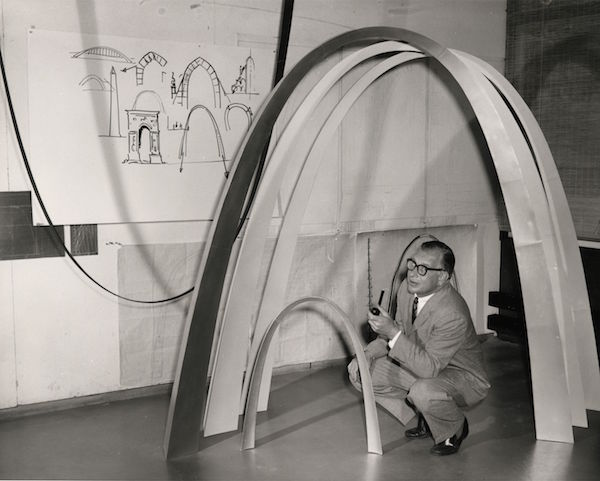 Eric Saarinen, ASC / Peter Rosen Productions, Inc.
Eric Saarinen, ASC / Peter Rosen Productions, Inc.
Architecture
Arms of Steel and Stone: A Father’s Cool Embrace
During a brief but productive solo career that lasted only a little over a decade—from his start in the late 1940s after working in his father Eliel Saarinen’s firm to his death in 1961—Eero Saarinen designed some of the most iconic modernist buildings in the United States, leaving a legacy that eludes most architects in an entire lifetime of work. How’d he do it? As Eero’s son Eric Saarinen testifies in Eero Saarinen: The Architect Who Saw the Future—an American Masters film produced and directed by Peter Rosen that premiered on PBS last December—by waking up and going to work at 7 am and returning from the office at 2 am. So much for a work-life balance.

Eero Saarinen with model and sketches of St. Louis’ Gateway Arch, ca. 1958. Manuscripts & Archives, Yale University Library
Accompanied by a camera crew and a drone shooting in 6K, Eric visits thirteen of Eero’s building sites in a quest to find out what his father was up to during all those hours spent away from home. On full display is the sheer force of the master architect’s imagination, from which sprung structures as different as the futuristic (and fascistic, according to some critics) Gateway Arch in St. Louis, the International Style–exemplar John Deere World Headquarters in Moline, Illinois, and the surreal, lithic Stiles Colleges at Yale. For Eero, it was all about the form. As architects Robert A. M. Stern and César Pelli and critics Paul Goldberger and Cathleen McGuigan attest in interviews for the film, it was Eero’s majestic forms that captured the ebullient spirit of postwar America better than the work of any other mid-century modern architect.
What about the 1950s nuclear family? While ostensibly a celebration of Eero Saarinen’s accomplishments, the film parenthetically emphasizes the cost of ambition. Eric is still coming to grips with what was an unsettled childhood. The synth strings of Moby’s score swell melodramatically when Eric talks about Eero’s passion for Aline Louchheim, the pert New York Times art critic (their letters are read in voiceover by Peter Franzén and Blythe Danner) whose love for his father broke up his parents’ marriage. You get the impression that Eric sees Eero as we, the public, see him—that is, from the outside, through his buildings. He recounts how, at age nineteen, attending his father’s funeral in the ethereal MIT Chapel designed by Eero, he could only think about how impersonal the building seemed, how small it made him feel. “I forgive him for his genius,” Eric says in the film, “How can you not forgive someone for being a genius?” Of course, even a genius can make the mistake of being married to his work.













